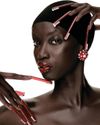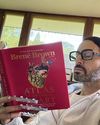
Though Emily Adams Bode Aujla, founder of Bode, has now designed her very first line of clothing for women, it’s not the first time she has designed women’s clothes. Students of Bode’s short but wildly successful history will note that while at school—simultaneously studying fashion at Parsons School of Design and philosophy at Eugene Lang College—Emily and her roommate routinely crafted their own clothes for the weekend ahead. “On Fridays, we would stay up late and make a skirt out of crushed velvet or something,” Emily remembers. Making women’s clothes, it seems, wasn’t so much a challenge as a natural occurrence. “It just came so naturally to me that I wasn’t as inspired by it.”
Other factors steered her early direction too: At Parsons, after one design assignment (“Astronauts, maybe?”), a professor suggested she had a knack for menswear. And then there was the prevailing teaching on fashion at the time (and especially women’s fashion), which could emphasize design over material. Emily, however, was fascinated by fabrics and cloth, particularly by textiles that were less inventive than historically pragmatic—textiles that had been worn by people, or many people. “I was more obsessed,” she says, “with something that was steeped in history and came from somebody’s closet.”
この記事は Vogue US の March 2023 版に掲載されています。
7 日間の Magzter GOLD 無料トライアルを開始して、何千もの厳選されたプレミアム ストーリー、9,000 以上の雑誌や新聞にアクセスしてください。
すでに購読者です ? サインイン
この記事は Vogue US の March 2023 版に掲載されています。
7 日間の Magzter GOLD 無料トライアルを開始して、何千もの厳選されたプレミアム ストーリー、9,000 以上の雑誌や新聞にアクセスしてください。
すでに購読者です? サインイン

FINAL CUT
\"WE WANT YOU TO GO FOR IT!\" ANNA TOLD ME

SCREEN TIME
Three films we can't wait to see.

Impossible Beauty
Sometimes, more is more: Surreal lashes and extreme nails put the fierce back in play

Blossoms Dearie
Dynamic, whimsical florals and the humble backdrops of upstate New York make for a charming study in contrasts.

HOME
Six years ago, Marc Jacobs got a call about a house designed by Frank Lloyd Wright. Making it his own, he writes, would be about love, commitment, anxiety, patience, struggle, and, finally, a kind of hard-fought, hard-won peace.

GIRL, INTERRUPTED
Anna Weyant found extraordinary fame as an artist before she had reached her mid-20s. Then came another kind of attention. Dodie Kazanjian meets the painter at the start of a fresh chapter

ROLE PLAY
Kaia Gerber is someone who likes to listen, learn, read books, go to the theater, ask questions, have difficult conversations, act, perform, transform, and stretch herself in everything she does. That she's an object of beauty is almost beside the point.

CALLAS SHEET
Maria Callas's singular voice made her a legend on the stage. In a new film starring Angelina Jolieand on the runwaysthe romance continues.

BOOK IT
A preview of the best fiction coming

GLOBAL VISTAS
Three new exhibitions offer an expansive view.